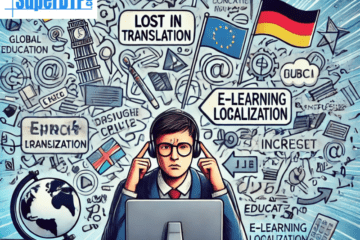In today’s globalized world, e-learning has become an essential tool for education and training. As organizations expand across borders, the need for effective localization of e-learning content is more important than ever. One key element of localization is subtitles. Subtitles not only enhance comprehension but also make content accessible to diverse learners. In this blog, we will explore the vital role that subtitles play in e-learning localization and how they can transform learning experiences for audiences worldwide.
Enhancing Understanding and Engagement
Subtitles are written text that appears on the screen while a video is playing. They provide a visual representation of spoken language, helping learners understand the content better. When e-learning materials are localized for different languages, subtitles ensure that learners can follow along with the audio, even if they are not fluent in the spoken language.
For example, a learner who speaks Spanish but is watching a training video in English can read the Spanish subtitles while listening to the English audio. This dual input—hearing the language and reading the translated text—enhances comprehension. As a result, learners are more likely to stay engaged and absorb the material. Subtitles act as a bridge between languages, enabling effective communication and learning.
Making Content Accessible to All
Accessibility is a crucial consideration in e-learning. Subtitles play a significant role in making content available to everyone, including those with hearing impairments. By providing subtitles, e-learning platforms ensure that individuals who are deaf or hard of hearing can access the same learning materials as their peers. This commitment to inclusivity is essential in today’s diverse learning environments.
Moreover, subtitles benefit learners who may struggle with language comprehension. Even if someone can hear the audio, they might find it challenging to understand specific accents or fast speech. Subtitles help these learners by providing a clear and readable text that they can follow at their own pace. This accessibility fosters a supportive learning environment where all individuals can thrive, regardless of their background or abilities.
Supporting Language Learning
For learners who are trying to improve their language skills, subtitles can be incredibly beneficial. Watching videos with subtitles allows learners to see the written form of the language while hearing it spoken. This combination reinforces language learning and helps improve vocabulary and pronunciation. Subtitles can also provide context to idiomatic expressions, which can be difficult to understand without a cultural reference.
In a language-learning course, for instance, learners can watch dialogues with subtitles in their target language. They can pause the video to look up unfamiliar words or phrases, enhancing their overall learning experience. Subtitles thus serve as a valuable resource for language learners, supporting their journey toward fluency.
Facilitating Cultural Adaptation
Localization goes beyond mere translation; it involves adapting content to resonate with the target audience’s culture. Subtitles play a key role in this cultural adaptation. When e-learning content is localized, subtitles can reflect cultural nuances, idioms, and references that may be specific to a particular region or demographic.
For example, a training video intended for a Japanese audience may include subtitles that incorporate culturally relevant examples. This attention to detail not only enhances comprehension but also fosters a connection between the content and the audience. By using culturally appropriate language in subtitles, e-learning providers can create a more engaging and relatable experience for learners.
Improving Learning Outcomes
The ultimate goal of e-learning localization is to improve learning outcomes. When subtitles are effectively integrated into e-learning content, they can significantly enhance the overall learning experience. Subtitles help learners process information more efficiently, leading to better retention of knowledge. Research has shown that learners who engage with multimedia content, such as videos with subtitles, often perform better in assessments compared to those who do not have access to such resources.
Additionally, subtitles can encourage active learning. As learners read along with the audio, they become more involved in the learning process. This active engagement promotes critical thinking and analysis, as learners are encouraged to connect ideas and concepts presented in the video.
Conclusion
In summary, subtitles play a crucial role in e-learning localization by enhancing understanding, making content accessible, supporting language learning, facilitating cultural adaptation, and improving learning outcomes. As e-learning continues to evolve and expand globally, the importance of effective localization strategies cannot be overstated. By incorporating subtitles, e-learning providers can create inclusive, engaging, and impactful learning experiences for diverse audiences. As we embrace the future of education, let us recognize the value of subtitles in breaking down language barriers and fostering a more connected world of learning.
Super DTP Ltd is a specialized desktop publishing agency located in Gabrovo Bulgaria, offering book publishing, multilingual DTP, and E-learning localization services to translation agencies and localization companies worldwide! Check our services at www.superdtp.com or contact us at dtp.bulgaria@gmail.com for further details


